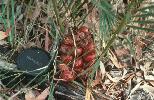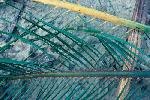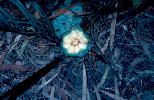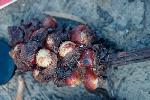Species profile—Macrozamia machinii
Classification
Plantae (plants) → Equisetopsida (land plants) → Zamiaceae → Macrozamia machinii

Go to Photo gallery
Species details
- Kingdom
- Plantae (plants)
- Class
- Equisetopsida (land plants)
- Family
- Zamiaceae
- Scientific name
- Macrozamia machinii P.I.Forst. & D.L.Jones
- WildNet taxon ID
- 6480
- Alternate name(s)
- Machin's macrozamia
- Nature Conservation Act 1992 (NCA) status
- Vulnerable
- Environment Protection and Biodiversity Conservation Act 1999 (EPBC) status
- Vulnerable
- Conservation significant
- Yes
- Confidential
- Yes
- Endemicity
- Native
- Pest status
- Nil
- Short Notes
- Gymnosperm, four sheets plus carpological
- Description
- Macrozamia machinii has a branched underground stem 20-30 cm in diameter, forming up to 10 crowns in a clump. The sparse to dense crown consists of 1-8 erect leaves 60-90cm long and hairless, except for wool at the base. Each leaf consists of 80-140 leaflets arranged on a dull green to yellow-green sprirally twisted (2-6 times) rhachis (central stalk). The thick, dull, dark green leaflets are 8-32cm long by 2.5-10mm wide and concave in cross-section. The leaflets are tapered to an asymmetrical tip and the leaflet bases are slightly thickened and yellow to orange or reddish.
The plants reproduce by cones which are somewhat pineapple-like in appearance. Male and female cones develop on separate plants. Male cones are more or less cylindrical and 8-20cm long by 4-6cm in diameter. Female cones are ovoid (egg-shaped) and 8-18cm long by 5-7cm in diameter. Seeds are oblong to egg-shaped, 2-2.5 cm long by 2-2.3cm in diameter, and orange to red when ripe.
Macrozamia machinii has been confused with M. plurinervia but differs from that species by the thicker leaflets which are dull green on both surfaces, the smaller cones and smaller seeds. They also occupy different habitats. (Jones & Forster 1994; Halford 1997; Hill 1998; DEWHA 2008) - Map
- View Map
- Habitat
- Macrozamia machinii occurs on flat plains an breakaways in deep sandy soils and in flat areas of open forest. (Halford 1997)
- Behaviour
- Pollination is by a species of Tranes weevil in an obligate mutualism. (Terry et al. 2005)
- Reproduction
- Mature cones have been recorded from September to December. Ripe seeds are present between February and April. Cones may not be annual when conditions are unfavourable. (Halford 1997)
- Predators
- All species of Macrozamia contain toxins which can cause debilitating symptoms or death if ingested in sufficient quantities. (Halford 1997)
- Management documents
- Conservation and management of protected plants in trade in Queensland 1995-1998. Department of Environment.
- Notes
- Contributors: Ailsa Holland, Mellisa Mayhew 18/06/2009
- References
- Department of the Environment, Water, Heritage and the Arts (2008). Macrozamia plurinervia in Species Profile and Threats Database, Department of the Environment, Water, Heritage and the Arts, Canberra. Accessed 08/10/2008.
Halford, D. (1997). Macrozamia machinii, in Species Management Manual. Department of Natural Resources, Brisbane.
Herbrecs (2008). Macrozamia machinii, in BriMapper version 2.12. Queensland Herbarium. Accessed 08/10/2008.
Hill, K.D. in McCarthy, P.M. (Ed) (1998). Flora of Australia 48: 655.
Jones, D.L. & Forster, P.I. (1994). Seven new species of Macrozamia section Parazamia (Miq.) Miq. (Zamiaceae section Parazamia) from Queensland. Austrobaileya 4(2): 276-278.
Terry, I., Walter, G.H.,Donaldson, J.D., Snow, E.L, Forster, P.I. & Machin, P.J. (2005). Pollination of Australian Macrozamia cycads (Zamiaceae): effectiveness and behaviour of specialist vectors in a dependent mutualism. Americal Journal of Botany 92: 931-940. - Profile author
- Ailsa Holland (18/06/2009)
Other resources
- Species Profile and Threats Database (SPRAT)
- The Australasian Virtual Herbarium (AVH)
- Atlas of Living Australia
Data source
This profile data is sourced from the QLD Wildlife Data API using the Get species by ID function used under CC-By 4.0.
https://apps.des.qld.gov.au/species/?op=getspeciesbyid&taxonid=6480.
This information is sourced from the WildNet database managed by the Queensland Department of Environment and Science.







